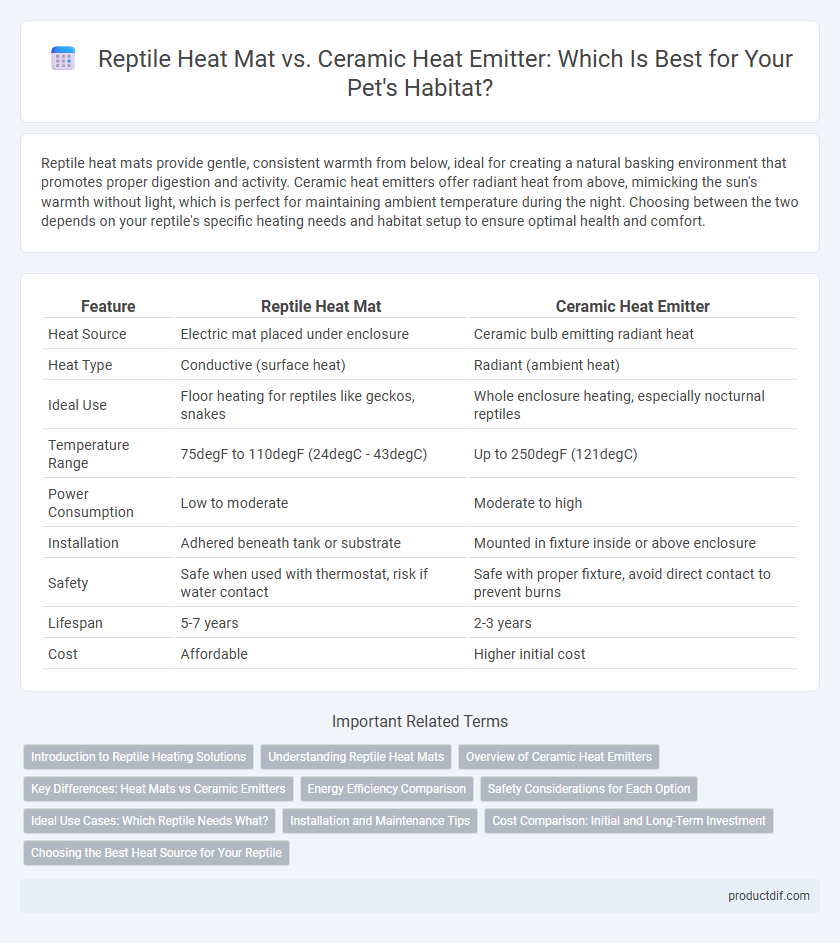Reptile heat mats provide gentle, consistent warmth from below, ideal for creating a natural basking environment that promotes proper digestion and activity. Ceramic heat emitters offer radiant heat from above, mimicking the sun's warmth without light, which is perfect for maintaining ambient temperature during the night. Choosing between the two depends on your reptile's specific heating needs and habitat setup to ensure optimal health and comfort.
Table of Comparison
| Feature | Reptile Heat Mat | Ceramic Heat Emitter |
|---|---|---|
| Heat Source | Electric mat placed under enclosure | Ceramic bulb emitting radiant heat |
| Heat Type | Conductive (surface heat) | Radiant (ambient heat) |
| Ideal Use | Floor heating for reptiles like geckos, snakes | Whole enclosure heating, especially nocturnal reptiles |
| Temperature Range | 75degF to 110degF (24degC - 43degC) | Up to 250degF (121degC) |
| Power Consumption | Low to moderate | Moderate to high |
| Installation | Adhered beneath tank or substrate | Mounted in fixture inside or above enclosure |
| Safety | Safe when used with thermostat, risk if water contact | Safe with proper fixture, avoid direct contact to prevent burns |
| Lifespan | 5-7 years | 2-3 years |
| Cost | Affordable | Higher initial cost |
Introduction to Reptile Heating Solutions
Reptile heat mats provide consistent, low-profile warmth ideal for creating a controlled basking area, while ceramic heat emitters offer radiant heat that evenly warms the entire enclosure without visible light. Both heating solutions maintain optimal temperatures essential for reptile metabolism, digestion, and overall health. Selecting the right option depends on the species' specific thermal requirements and enclosure setup.
Understanding Reptile Heat Mats
Reptile heat mats provide consistent, gentle warmth by emitting heat through a flat surface, making them ideal for under-tank heating and maintaining stable temperatures for reptiles' basking areas. Unlike ceramic heat emitters, which produce radiant heat without light and can lead to uneven heat distribution, heat mats promote gradual heat absorption, reducing the risk of burns or overheating. Optimal placement and temperature regulation with thermostats ensure effective thermal environments, supporting reptile metabolism and digestion.
Overview of Ceramic Heat Emitters
Ceramic heat emitters provide consistent, infrared heat without light, making them ideal for nocturnal reptiles and maintaining natural day-night cycles. Unlike reptile heat mats, ceramic heat emitters can be positioned above the enclosure, offering more flexible and efficient heat distribution. Their durability and long lifespan make them a reliable option for creating a warm, comfortable environment essential for reptile thermoregulation and overall health.
Key Differences: Heat Mats vs Ceramic Emitters
Reptile heat mats provide gentle, consistent warmth by emitting heat directly to the tank floor, making them ideal for belly heat essential for reptiles' digestion. Ceramic heat emitters radiate heat without light, delivering higher temperatures for ambient warming but require careful monitoring to avoid overheating. Choosing between heat mats and ceramic emitters depends on the reptile species' thermal needs and habitat setup, emphasizing substrate heating versus air temperature control.
Energy Efficiency Comparison
Reptile heat mats generally offer higher energy efficiency by providing consistent, low-watt heat directly to the enclosure floor, reducing overall power consumption. Ceramic heat emitters consume more electricity as they radiate heat without light, requiring higher wattage to maintain optimal temperature levels. Choosing a heat mat can lead to lower energy bills and a more eco-friendly reptile habitat.
Safety Considerations for Each Option
Reptile heat mats offer consistent, low-wattage warmth and are generally safer for providing belly heat without the risk of burns, but they require a thermostat to prevent overheating. Ceramic heat emitters emit radiant heat without light, making them ideal for maintaining ambient temperature; however, they can become extremely hot to touch, necessitating secure placement and protective guards to avoid burns or fire hazards. Both options demand carefully monitored setups and temperature controls to ensure the safety and well-being of reptiles in their habitat.
Ideal Use Cases: Which Reptile Needs What?
Reptile heat mats provide gentle, consistent warmth ideal for ground-dwelling species like geckos and snakes that require belly heat to aid digestion. Ceramic heat emitters generate radiant heat without light, making them perfect for nocturnal reptiles such as bearded dragons and crested geckos that need ambient warmth during cooler nighttime hours. Understanding species-specific thermoregulation needs ensures proper habitat temperatures, promoting reptile health and activity levels.
Installation and Maintenance Tips
Reptile heat mats install easily by placing them under or beside the enclosure, requiring minimal setup and no external fixtures, making them ideal for beginners. Ceramic heat emitters need to be screwed into a compatible lamp fixture and position carefully to prevent overheating, necessitating regular monitoring and bulb replacement. Both devices should be paired with thermostats to maintain safe temperatures and extend their lifespan through routine cleaning and inspection.
Cost Comparison: Initial and Long-Term Investment
Reptile heat mats typically have a lower initial cost, usually ranging from $15 to $30, while ceramic heat emitters can cost between $20 and $50. Over the long term, heat mats tend to be more energy-efficient, consuming around 10 to 20 watts, compared to ceramic emitters that require 60 to 100 watts, resulting in higher electricity bills. Replacement frequency also impacts cost, as ceramic heat emitters need bulb replacements every 6 to 12 months, whereas heat mats can last several years with proper care.
Choosing the Best Heat Source for Your Reptile
Selecting the ideal heat source for your reptile depends on species-specific temperature requirements and enclosure size. Reptile heat mats provide consistent, gentle warmth from beneath, ideal for ground-dwelling reptiles needing belly heat, while ceramic heat emitters deliver radiant heat without light, suitable for creating ambient warmth in larger or vertically structured habitats. Balancing energy efficiency, temperature control, and safety features ensures optimal thermoregulation and health for your reptile pet.
Reptile heat mat vs Ceramic heat emitter Infographic

 productdif.com
productdif.com